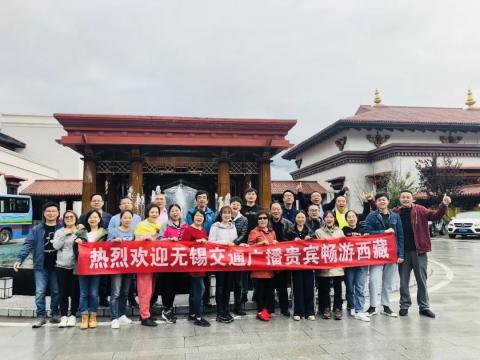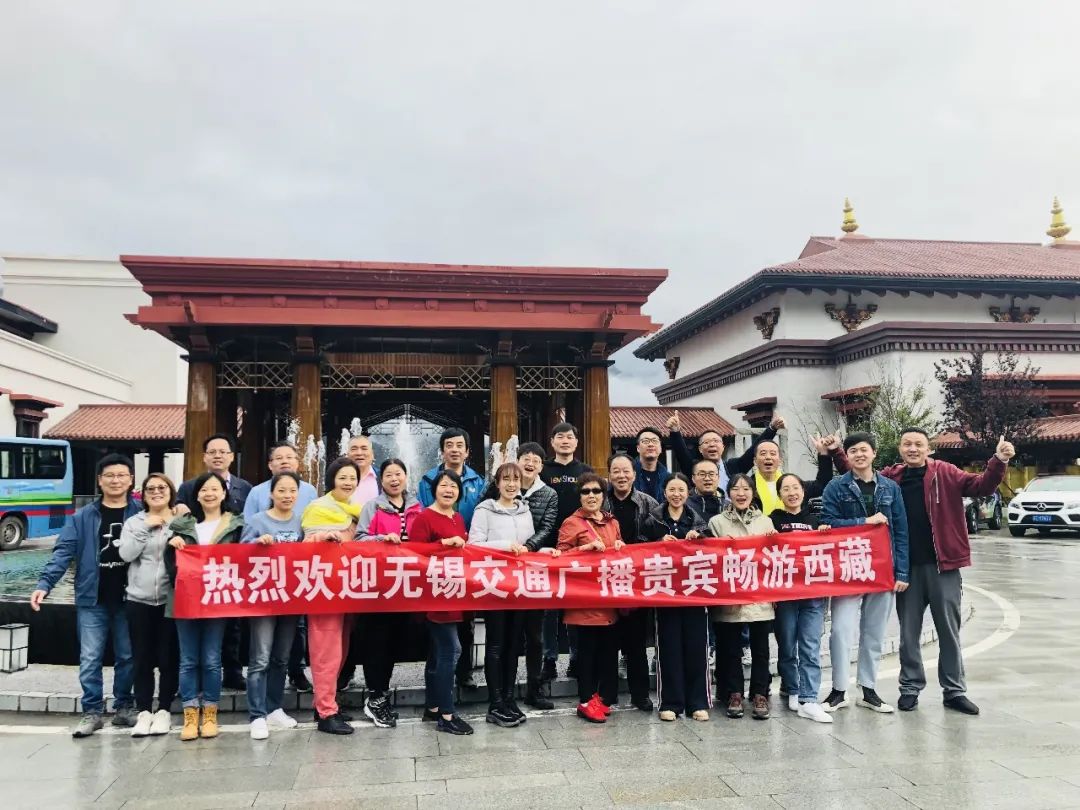
01——Come to Tibetan Folk Village
Today is the fourth day in Tibet. We took a group photo together in the morning. This time we came to Tibet with a group from Wuxi Traffic Radio and Television Station.

In the morning, we had an in-depth understanding of the life of the Tibetan people. We visited the Tibetan Folk Village. While in the car, the tour guide Huahua introduced some precautions when entering the village.
The first is a polite response. When Tibetans say Tashi Delek to us, we have to respond with "Tashi Delek Show", which means good luck and good luck. In fact, it is a hada culture. The younger generation cannot offer hada to their elders; peers should reach out to pick up the hada and carry it themselves; when the elders offer hada, they can directly carry it on your head.
After learning some precautions, we followed the Tibetans to her home.
There are no photos here because we are visiting his home. Home is where relatives live together, and many of the items have been opened. After entering the room, the surroundings are surrounded by patterns drawn one by one, which are very beautiful. We drank milk with salt and heard many stories about Tibetan life.
Dolma who received us shared how she went from Shigatse to Nyingchi. When the old Tibetans refused to move, neither the Tibetan aid cadres nor the Tibetan cadres in Shigatse could convince them. It was not until the Living Buddha finally came to do the work that they Agree to move and let the children go to the city for education.
This illustrates the status of the Living Buddha in the hearts of Tibetans and the power of faith.
02The culture of the folk village
When I was in Shigatse, the saddest thing was winter. Cow dung couldn’t be dried in winter. I didn’t dare to use the cow dung for heating. I would only take it out to sit in a circle when guests came. Normally, it would be in the cow dung. In the circle, stones are piled up to the height of a person's chest to form a circle of stones. Cows surround the circle. The heat emitted by the cows can make Tibetans feel better in winter.

Now three Tibetan families from Shigatse have moved here. The entire folk village contains thirty-six families. The houses are all resettlement houses built with the aid of the corresponding city. Each house has a five-star red flag on it. The main task of this village is to allow friends who travel to Tibet to truly understand the life of Tibetans.
Grandpa Dolma is a Tibetan doctor, so he explained a lot about Tibetan medicine when introducing Tibetan culture and life. He helped an elder brother take care of his shoulder and neck on the spot, scraping the disease with a silver bowl, and then harvesting it. It also introduces some Tibetan medicine tips that you can take care of at home, such as rhinitis, pharyngitis, big belly, etc.
Regarding health, the Tibetan people's philosophy is that prevention is better than cure. They will take prevention from the food they eat, their attitude towards doing things and their concepts of encountering things, that is, from both the physical and spiritual aspects.
As for food, they eat very simple things, such as milk, butter tea, tsampa, beef, etc.
The attitude towards things is that there is always a solution to everything, just work hard to solve the problem. It is useless to think about things that have no solution. Dolma said that there is really no depression or suicide in Tibet.
Why do they take health so seriously? It starts with their beliefs. Tibetan people's spiritual practice in this life is to cultivate the next life, so after death, they all hope to be buried in the sky. If they want to be buried in the sky, they must be in good health, have no surgery, have sound limbs and other requirements. Sky burial is the choice to return all the meat that one has eaten throughout his life to nature. This is complete. If Tibetans cannot be buried in the sky, they will eventually be cremated and then sprinkled on the land. This is called returning to nature.
This is actually the Tibetan people's view of life and death. While alive, they must complete 100,000 life-long heads. While alive, they must do more good deeds and cultivate blessings. While alive, they must work hard and be responsible for themselves and their families.
03Tibetans’ concepts
Therefore, the Tibetan people's view of money is this. You have to work hard, and you will gain something from your labor. Part of the money earned is used for daily needs, part of it is used to buy some accessories for oneself, and part of it is given to the Buddha.
Dolma said that the three items her parents bought for her were a silver bowl, a silver comb, and a silver belt. There are no others. If Dolma gave birth to many children and the house was not enough to live in, her parents would not pay to build a house for her, but would let the children solve the problem themselves.
In one sentence, the summary is: Children can make money without their parents giving money. If children cannot make money, the money given to them will be spent. Therefore, after Tibetans pass away, they will donate all their money to the Buddha.
This is different from many of our views on money. Many of our parents want to give everything to their children and think too much about and take care of their children.
This is related to the Tibetan people’s view on education, which I very much agree with.
The first is parents’ precepts and deeds. Tibetans will teach their children how to do it, and won’t they keep giving orders or telling their children what to do?
The second is the willingness and willingness to let go of the child's independence, let the child do what he should do, and let the child try. For example, when a child cannot help but rush to drink hot butter tea when visiting a guest, and the child gets burned, the parents next to him will laugh.
The reason for laughter is that the child has experienced what it means to be hot. In the future, he will not touch the big pot of hot water and knows what can and cannot be done.
After listening to Dolma's introduction, I gained an understanding of Tibetan life. I was deeply inspired from the perspectives of health, money and educating children.
Everyone should take care of themselves, be responsible for what they do, be financially independent and not dependent on others, and at the same time be a role model for their children, teach by words and deeds, and let their children experience their growth.
04——Mila Pass——Sijinlacuo Sacred Lake
After visiting the Tibetan Folk Village, we first came to Mira Pass and took a group photo at an altitude of more than 5,000 meters.

Then drive to Sijin Lacuo, God of Wealth Lake. The miraculous workmanship of nature, the two mountains are like gold ingots on both sides of the lake. There are a lot of gold, silver, jewelry and money left by everyone in the lake for blessing, and there are also many Mani piles for blessing, and there are blessed Hadas on the Mani piles. on top.

This is the power of faith. Everyone prays for good things in their hearts, a healthy body, a happy family, a peaceful life, and prayers for money.

A group of us slowly came to the lake and felt the God of Wealth wind blowing from the lake. When we returned, we encountered ice and rain. We felt the rain in Tibet, the ice was thin, and we felt the altitude here. Even though we were soaked to the skin, we were still very happy.
The day's trip ended when we arrived at the hotel at 8:40. My body was a little tired, but my mind was shocked. Tomorrow we will go to Jokhang Temple and Potala Palace, the paradise in every pilgrim's heart.
